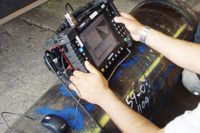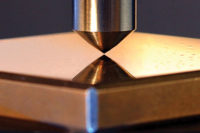Analysis of the Global Ultrasonic Non-destructive Test Equipment Market
http://www.reportlinker.com/p01870914/Analysis-of-the-Global-Ultrasonic-Non-destructive-Test-Equipment-Market.html#utm_source=prnewswire&utm_medium=pr&utm_campaign=Machine_Tool_and_Equipment
Phased Array Ultrasonic Test Equipment Outpacing the Market
The global ultrasonic non-destructive test (NDT) equipment market was impacted severely by the economic recession of 2009 to 2010. Since then, the market has done well to maintain a stable growth rate. This market engineering study discusses the current state of the total global ultrasonic NDT equipment market; it provides analyses for the following segments: thickness gauges, digital flaw detectors, phased array flaw detectors, and test machines. Regions covered include North America,Europe, Asia-Pacific, and ROW. The study also gives an overview of the current trends impacting this market, the size of the market, its future potential, and its competitive environment. The base year is 2012, and the forecast period is 2013 to 2017.
Key Findings
•The highest revenue generated in the ultrasonic nondestructive test (NDT) equipment market is from the test machines segment, whereas the highest volume sales is in the thickness gauges segment.•Phased array flaw detectors represent the highest growing segment in the ultrasonic NDT equipment market, both in terms of revenue and volume.•The average price per unit in the phased array flaw detectors segment is decreasing at a rapid rate, with a X% reduction in price forecasted from 2012 to 2017.•Within the phased array flaw detector segment, existing participants are introducing more new products than before, and new participants are entering this booming segment.•Oil and gas—followed by power generation and aerospace, military, and defense—is the highest revenue contributor to the ultrasonic NDT equipment market.•The market is growing the most in Rest of World (ROW), with growth occurring in the Middle East, Africa, and South America.•GE Measurement and Control Solutions and Olympus NDT are the leading market participants. Sonatest PLC is a distant third.•The highest number of participants exist in the test machines market segment, which is dominated by system integrators.
CEO's Perspective
1. In this market, year-over-year unit sales vary considerably, and the market is quite dependent on general economic conditions.2. Equipment manufacturers are moving toward low-end phased array flaw detectors that provide basic functionalities.3. Because of maturing technology, customers have placed extra emphasis on equipment features and software capabilities.4. High growth regions include regions in ROW, such as the Middle East, Africa, and Latin America (especiallyBrazil).5. A lack of skilled technicians, especially in the phased array ultrasonic testing segment, means that equipment must be easy to use.
Market Definitions
Geographic Coverage: GlobalStudy Period: 2009–2017Base Year: 2012Forecast Period: 2013–2017Monetary Unit: US DollarsConversion Rate: $1.00 = € - $1.00 = £X
•For the purpose of this study, the market is defined as the revenue generated by the ultrasonic NDT equipment manufacturers and the system integrators that sell integrated test machines globally.
•The geographic scope is global and is segmented as follows:
oNorth America—includes the United States and Canada
oEurope: includes Belgium, France, Denmark, Scandinavia, Germany, Italy, Luxembourg, the Netherlands, Spain, Portugal,Greece, Turkey, Russia, the United Kingdom, Serbia, Slovakia, Croatia, Romania, Bulgaria, Estonia, Belarus, Hungary,Azerbaijan, the Czech Republic, Ireland, Switzerland, Poland, and Ukraine
oAsia-Pacific—includes Greater China (China, Hong Kong, and Taiwan), Japan, South Korea, Pakistan, North Korea, India, ASEAN* countries (Singapore, Malaysia, Indonesia, The Philippines, Thailand, and Vietnam), Central Asian countries (Kazakhstan, Uzbekistan, Turkmenistan, Tajikistan, Kyrgystan) Australia, and New Zealand
oRest of World—includes countries in Latin America (such as Brazil, Mexico, Argentina, and other countries in Central andSouth America as well as in the Caribbean), the Middle East, and Africa
The different product segments included in this study are as follows:
Thickness Gauges
—these are instruments that utilize conventional ultrasonic principles and can be operated in different modes such as pulse echo, multiple echo, or echo to echo. These modes define how the measurement is made. The thickness gauges can be further sub divided into precision gauges and corrosion gauges. Corrosion gauges are used to measure the remaining wall thickness in metal pipes, tanks, structural parts, and pressure vessels that are affected by internal corrosion. Precision gauges are more applicable in the aerospace and automotive industries, which require greater accuracy in measurements and the ability to measure thin metals.
Digital Flaw Detectors
—Also known as mono-channel flaw detectors, these are instruments that operate on conventional ultrasonic principles and typically possess 1 to 4 channels for measurement. Most digital flaw detectors are extremely portable, with the handheld variants being very popular. This segment includes high-end benchtop variants, as well.
Phased Array Flaw Detectors
—These work on the phased array ultrasonic principles and are typically combined with time-of-flight diffraction (TOFD) to provide a holistic ultrasonic testing instrument. Based on features, phased array ultrasonic flaw detectors can be sub-divided into low-end, mid-end, and high-end varieties. The low-end and mid-end detectors are portable instruments, whereas the high-end ones are benchtop instruments. Any portable or benchtop unit that possesses phased array ultrasonic capability is included in this segment.
Test Machines
—These are systems sold mostly by system integrators for use in a manufacturing environment. These systems are typically integrated with the production lines that include mechanical frames. These can also be used offline as a fixed-test system. They are highly customized for specific applications and end-client needs. This segment includes revenue generated from mechanical systems, as well.
The end-user industries covered in this study are as follows:
•Oil and Gas—includes refineries, on-shore and offshore oil and gas wells and rigs, on-shore and off-shore oil and gas pipelines, and chemical and petrochemical plants
•Power Generation—includes energy companies; utilities; and co-generation, renewable, and non-renewable power plants.
•Aerospace, Military, and Defense—includes commercial and private aviation and military- and defense-related research labs
•Automotive and Transportation—includes the automotive and transportation industries, such as roadways and railways
•Others—includes government and educational institutions; process industries; the mining industry; and companies involved with inspecting civil infrastructure, which includes such structures as buildings, bridges, and stadiums
Revenue for all end-user industry segments includes equipment sold for both testing during the manufacturing of individual components—such as tubes, bars, pipes, plates, strips, vessels, billets, and castings—and the in-service inspection of these components.
The scope of this study does not include guided wave ultrasonic testing, laser ultrasonic testing, corrosion monitoring that uses permanently installed ultrasonic sensors, ultrasonic transducers, and the probes that are sold individually as consumables and not with new equipment.
Key Questions This Study Will Answer • Is the ultrasonic NDT equipment market growing, how long will it continue to grow, and at what rate?
• What are the strategic growth regions and the factors driving and restraining these markets?
• How is the competition in the market structured? What is the competitive environment for individual product segments?
• Which end-user industry segments will offer growth opportunities in the next 5 years?
• Are the products/services offered today meeting customer needs or is additional development needed?
• Which product segments offer the highest growth opportunities, both in terms of revenue and volume sales?
Table Of Contents 1. Executive Summary
2. Market Overview
3. Total Ultrasonic NDT Equipment Market
• Drivers and Restraints
• Forecast and Trends
• Market Share and Competitive Analysis
4. Thickness Gauges Segment Breakdown
5. Digital Flaw Detectors Segment Breakdown
6. Phased Array Flaw Detectors Segment Breakdown
7. Test Machines Segment Breakdown
8. North American Breakdown
9. European Breakdown
10. Asia-Pacific Breakdown
11. Rest of World Breakdown
12. The Last Word
13. Appendix
To order this report: Analysis of the Global Ultrasonic Non-destructive Test Equipment Markethttp://www.reportlinker.com/p01870914/Analysis-of-the-Global-Ultrasonic-Non-destructive-Test-Equipment-Market.html#utm_source=prnewswire&utm_medium=pr&utm_campaign=Machine_Tool_and_Equipment
SOURCE Reportlinker




